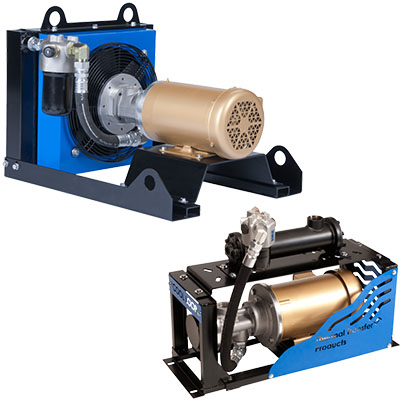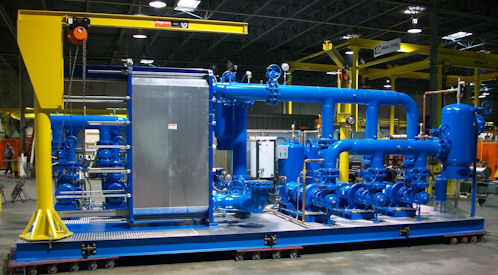A Comprehensive Overview to Picking the Right Heat Transfer Solutions for Your Needs
Picking the suitable Heat transfer system is essential for operational efficiency. Different systems satisfy different requirements, affected by factors such as temperature level array and fluid kind. Comprehending the principles behind Heat transfer, such as radiation, transmission, and convection, is important. In addition, assessing energy resources and upkeep techniques can impact long-term efficiency. A closer assessment of these considerations exposes exactly how to tailor a system to specific needs. What should one prioritize in this complicated decision-making process?
Recognizing Heat Transfer: Trick Concepts and Concepts
Heat transfer might appear like an uncomplicated concept, it incorporates an array of principles that are basic for effective system layout - DVS Heat Transfer Systems. Recognizing these concepts is necessary for engineers and developers that intend to optimize thermal performance in numerous applications. Transmission, for example, includes the transfer of Heat via strong products, while convection refers to the activity of Heat within liquids. Radiation, one more vital principle, explains exactly how Heat can be transferred with electromagnetic waves. Each of these devices plays an essential function in identifying just how energy relocates within a system. By thoroughly grasping these concepts, professionals can make educated decisions, ensuring that Heat transfer systems operate efficiently and fulfill the details demands of their applications
Kinds Of Heat Transfer Equipments: A Review
Recognizing the concepts of Heat transfer prepares for checking out the different sorts of Heat transfer systems available. Heat transfer systems can be categorized mainly into 3 types: radiation, convection, and transmission. Transmission entails Heat transfer with solid products, depending on straight contact in between fragments. Convection, on the other hand, happens in fluids (gases and liquids) where the motion of the fluid itself helps with Heat transfer. Radiation involves the transfer of Heat via electromagnetic waves and does not need a medium, allowing it to take place in a vacuum. Each kind of system has distinctive features and applications, making it essential for individuals and companies to meticulously evaluate their specific demands when choosing one of the most suitable Heat transfer option.
Applications of Heat Transfer Solutions in Various Industries
Heat transfer systems play an important role across various markets, impacting effectiveness and item high quality. In industrial manufacturing processes, they promote specific temperature control, while in food and beverage processing, they ensure safety and security and conservation. Additionally, HVAC and climate control systems depend heavily on efficient Heat transfer to keep comfy atmospheres.
Industrial Manufacturing Processes

Various commercial production processes count heavily on effective Heat transfer systems to take full advantage of performance and improve product high quality. In markets such as metalworking, Heat exchangers play an important function in preserving excellent temperature levels throughout welding, spreading, and forging. These systems assure consistent Heat distribution, which is crucial for accomplishing desired product residential or commercial properties. Similarly, in the chemical production market, Heat transfer systems help with precise temperature level control during reactions, influencing yield and security. In textile manufacturing, efficient Heat management is essential for coloring and finishing processes, influencing shade uniformity and fabric top quality. By choosing ideal Heat transfer innovations, manufacturers can boost power efficiency and decrease operational expenses, eventually causing a much more lasting and competitive manufacturing environment.
Food and Beverage Handling
Efficient Heat transfer systems are just as vital in the food and beverage handling sector, where maintaining ideal temperature levels is vital for food security and top quality. These systems play an important function in procedures such as sterilization, pasteurization, and food preparation, guaranteeing that items are secure for consumption and maintain their dietary value. Heat exchangers, for example, efficiently move Heat in between fluids, optimizing energy usage while minimizing temperature level variations. Furthermore, refrigeration systems are basic for expanding and maintaining subject to spoiling things service life. The option of Heat transfer modern technology directly impacts functional effectiveness and product integrity, making it necessary for food and beverage producers to pick the proper systems tailored to their particular processing demands. This cautious selection ultimately adds to customer fulfillment and food security.

Heating And Cooling and Environment Control
While many markets rely upon Heat transfer systems for performance, COOLING AND HEATING (Home Heating, Ventilation, and A/c) plays an essential duty in keeping interior environment control across numerous settings. These systems utilize Heat transfer concepts to regulate air, temperature, and moisture high quality, making certain convenience and security in residential, industrial, and commercial settings. Effectively created heating and cooling systems enhance power efficiency, reduce operational prices, and reduce environmental impact. In commercial buildings, for instance, efficient environment control adds to staff member productivity and consumer fulfillment. In commercial applications, heating and cooling systems help keep excellent problems for devices see this here operation and product conservation. Selecting the best Heat transfer system is vital for conference specific climate control requirements and accomplishing general system performance.
Examining Energy Resources for Heat Transfer Equipments
In assessing power sources for Heat transfer systems, a contrast of renewable resource options and nonrenewable fuel source factors to consider is vital. Sustainable resources, such as solar and wind, deal lasting choices that can minimize ecological impact. On the other hand, fossil fuels continue to be common due to their well established facilities and power density, prompting a mindful evaluation of both choices.
Renewable Power Options

Fossil Gas Factors To Consider
Evaluating nonrenewable fuel source considerations is crucial for the efficiency and sustainability of Heat transfer systems. Fossil gas, such as gas, oil, and coal, are traditional energy resources that give substantial Heat outcome, making them preferred selections for domestic and industrial applications. Their ecological impact, including greenhouse gas exhausts and resource depletion, increases issues. When selecting a warm transfer system, it is vital to assess the schedule, price, and regulative elements connected with these fuels. In addition, the performance of nonrenewable fuel source systems must be considered, as greater effectiveness can alleviate some environmental disadvantages. Inevitably, a balanced technique weighing efficiency and sustainability can lead decision-makers towards the most suitable Heat transfer service for their specific demands.
Variables to Think About When Choosing a Heat Transfer System
Picking a proper Heat transfer system requires mindful factor to consider of various factors that can substantially affect efficiency and efficiency. One vital element is the operating temperature level range, which determines the materials and layout suitable for the application. Furthermore, the kind of liquid used in the system-- whether gas or fluid-- impacts Heat transfer performance and compatibility. The system's size and capacity must line up with the certain requirements of the procedure to avoid ineffectiveness. Power source accessibility is also necessary, affecting operating expense and sustainability. The installation environment, including area constraints and ease of access for maintenance, plays a considerable duty in system choice. Finally, regulative compliance and safety and security criteria need to be considered to ensure browse around this site the system meets all legal needs.
Upkeep and Effectiveness Optimization for Heat Transfer Systems
Keeping Heat transfer systems is necessary for guaranteeing optimal efficiency and long life. Normal maintenance tasks, such as cleaning Heat exchangers and evaluating insulation, help protect against effectiveness losses as a result of fouling and thermal linking. Additionally, keeping track of system parameters, consisting of stress and temperature level, enables very early detection of abnormalities, minimizing downtime and expensive fixings. Applying a precautionary upkeep timetable can optimize performance and prolong the life expectancy of parts. Upgrading to sophisticated control systems can enhance check over here functional performance by readjusting to varying problems and loads. By prioritizing maintenance and performance optimization, drivers can achieve decreased energy intake, lower operational costs, and boosted total system integrity, eventually causing far better source use and a much more sustainable operation.
Future Trends in Heat Transfer Technologies
As markets significantly focus on sustainability and energy effectiveness, future patterns in Heat transfer innovations are set to go through significant makeovers. Innovations such as advanced products, consisting of carbon nanotubes and nanofluids, guarantee improved thermal conductivity and efficiency. In addition, the integration of sustainable energy resources into Heat transfer systems is acquiring momentum, promoting environment-friendly options. Smart innovations, including IoT sensing units, are anticipated to change surveillance and control, making it possible for real-time information analysis for enhanced performance. The development of small and modular systems will assist in easier installment and maintenance, providing to varied applications. These developments indicate a change in the direction of more lasting, reliable, and versatile Heat transfer services, aligning with international energy objectives and environmental requirements.
Frequently Asked Questions
What Are the Environmental Effects of Heat Transfer Systems?
The ecological effects of Heat transfer systems can consist of greenhouse gas emissions, power usage, and prospective thermal pollution. In addition, inappropriate disposal of inadequacies and materials can add to resource exhaustion and ecosystem interruption.
Exactly how Do I Calculate the Cost-Effectiveness of a Warmth Transfer System?
To determine the cost-effectiveness of a warm transfer system, one should evaluate initial costs, functional costs, maintenance demands, and power effectiveness, contrasting these elements against the anticipated life expectancy and efficiency of the system.
Can Heat Transfer Equipment Be Used in Residential Settings?
Heat transfer systems can undoubtedly be utilized in residential settings. They supply reliable home heating and cooling remedies, making homes more comfortable while possibly decreasing power prices. Their flexibility enables for various applications in household settings.
What Safety Laws Relate To Heat Transfer Solutions?
Safety and security laws for Heat transfer systems commonly consist of standards on operation, maintenance, and setup. Conformity with neighborhood building ordinance, manufacturer requirements, and sector requirements is necessary to ensure reliable and risk-free system performance in various applications.
How Do Different Products Affect Heat Transfer Effectiveness?

Conduction, for circumstances, includes the transfer of Heat through solid products, while convection refers to the activity of Heat within liquids. Understanding the principles of Heat transfer lays the foundation for discovering the various types of Heat transfer systems offered. Heat exchangers, for instance, efficiently move Heat in between liquids, enhancing power use while reducing temperature variations. In assessing energy resources for Heat transfer systems, a comparison of renewable energy alternatives and fossil gas considerations is essential. Steels, such as copper and aluminum, conduct Heat effectively, whereas insulators like rubber and glass reduce down Heat circulation.